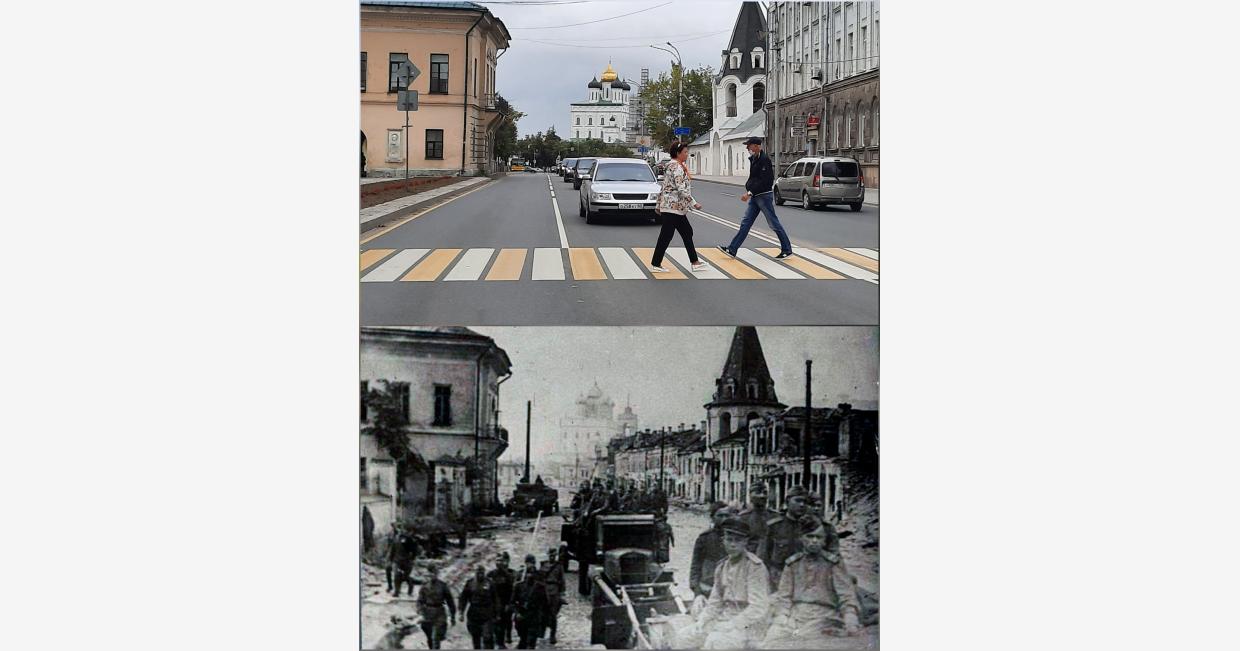Oktyabrskaya square, Pskov. July 1944 / Oktyabrskaya square, Pskov. August 2021
Red Army units marching across the liberated Pskov.
From the collection of memoirs of 128th Pskov Red-Banner Rifle Division. "Pskovskaya Krasnoznamyonnaya". Lenizdat, 1984. [In the course of the war the division was awarded the honorary Red Banner as a sign of distinction and the honorific name "Pskovskaya" for its heroic performance in the liberation of Pskov - Alexander Shmidke]
"The enemy's sudden withdrawal forced 42nd Army units to act immediately with the forces at hand. And these forces were extremely limited. Rifle divisions were barely up to 1/2 of their personnel strength. The Hitlerites secured their retreat with strong rear guard units, so our infantry had a hard time both breaking through the Panther Line and clearing the eastern part of the city of the enemy.
The main strike force that led the attack on Pskov were 128th and 376th Rifle divisions. This was very little for a town of this size. Their detachments got dispersed, drowned in the ruins that sprawled over many kilometers. In addition, all the ground was chock full of mines and delayed action explosives, while the streets were barricaded by ruins of blown up buildings and felled trees. It must be noted the tree trunks were not sawed but torn off by explosives. TNT charges were fixed to tree trunk bases and groups of neighbouring trees were connected by a common fuse wire. A quick turn of the switch created road blockages made up of felled tree trunks which spanned for several dozen meters. The Hitlerites blew up the railroad in the same serial fashion as the trees, only planting several times more explosives. This hindered our advance under the fire of the retreating enemy even more.
The railroad was a terrifying sight to behold. In the last moments before their retreat the Hitlerites wrecked it in two different ways. At some sections of the railroad they ripped timbers and rails off with a special gigantic "rake" towed by two twinned steam engines. At some other sections they blew it up in the same serial fashion as they did to the trees, only planting way more explosives. Huge craters not only seared the railroad embankments across - they went several meters deep under it. The craters were filled with groundwater.
The greatest challenge for the soldiers of the 128th was the forcing of Velikaya river. Once again, very few standard issue boats and pontoons were ready at hand due to the sudden start of the offensive - most of them were still behind in the area of Ostrov, the breakthrough point of the offensive. This was the reason why this quite formidable obstacle had to be crossed on all sorts of makeshift floats, or sometimes simply by swimming across. Not only scouts and assault groups, but also the main forces of the rifle regiments managed to get across the river Velikaya in this fashion before the pontooners arrived. In two days, from July 22nd to July 23rd, Pskov was cleared of the enemy.
